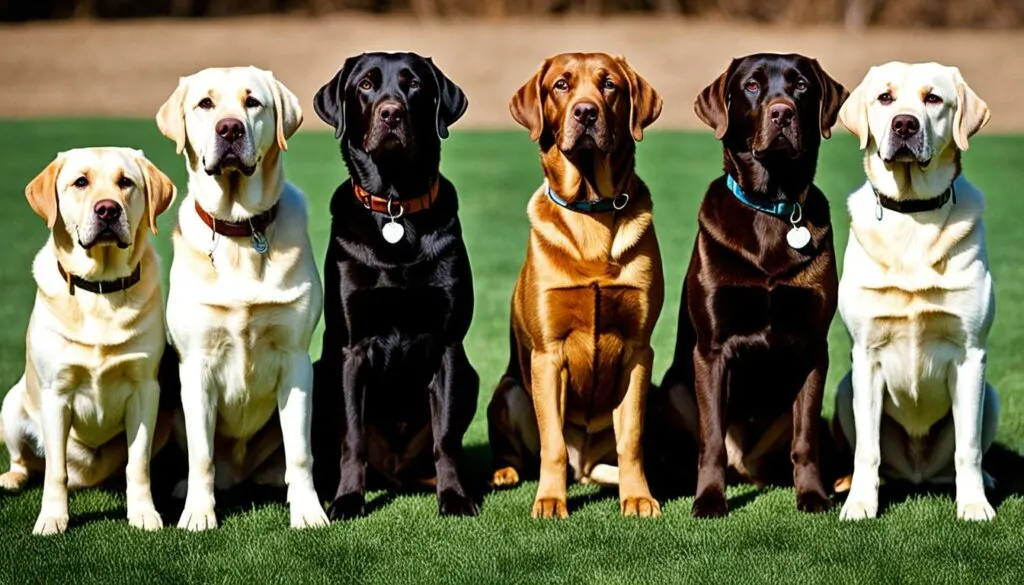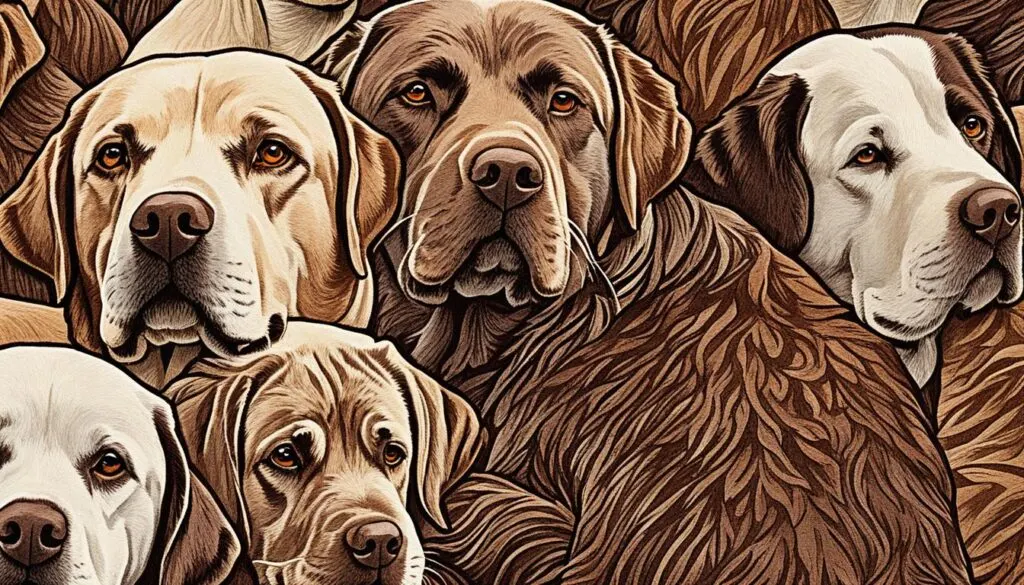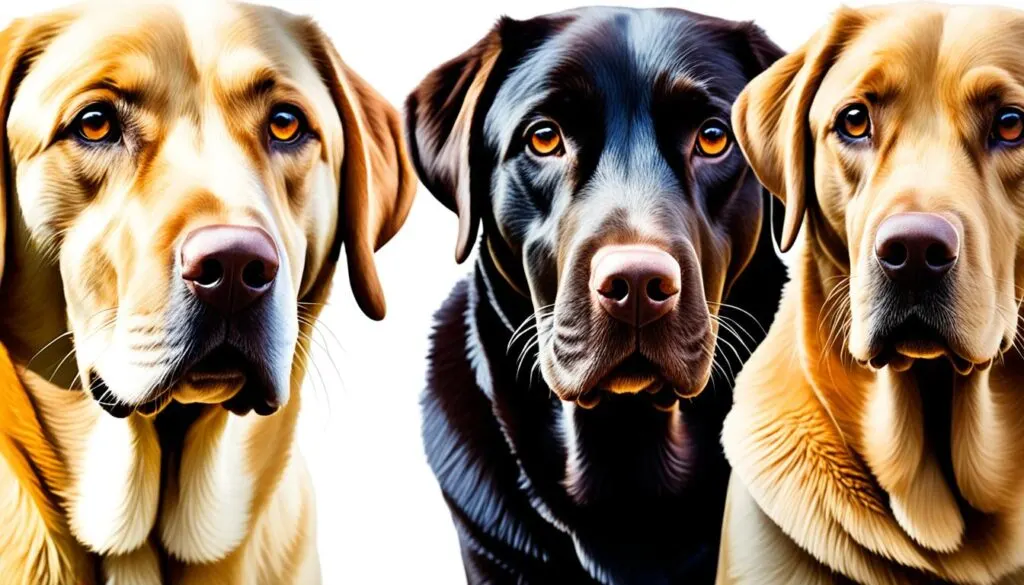Labrador Retrievers are well-known for their friendly demeanor and versatility, but did you know that they also come in a wide range of coat colors?
From the classic black to the striking silver and everything in between, Labradors showcase a spectrum of colors that captivate the eye and reflect their unique genetic makeup.
In this article, we will take an in-depth look at the fascinating world of Labrador coat colors.
We will explore the genetics and inheritance patterns that contribute to the different coat variations seen in this beloved breed.
Additionally, we will provide a visual chart to help you better understand the stunning array of options available when choosing a Labrador companion.

Click Here to Jump to a Section
Key Takeaways:
- Labradors come in a diverse range of coat colors, from black and yellow to chocolate and champagne.
- Coat color genetics play a significant role in determining the colors seen in Labradors.
- Labrador coat inheritance follows complex patterns, influenced by both dominant and recessive genes.
- Understanding coat pigmentation factors, such as nutrition and environment, is crucial for maintaining the vibrancy of a Labrador’s coat.
- DNA testing can provide valuable insights into a Labrador’s coat color and pigmentation.
Understanding Labrador Coat Genetics
In the world of Labrador Retrievers, coat genetics play a pivotal role in determining the wide range of colors and patterns seen in these beloved dogs.
Understanding how specific genes contribute to coat colors is key to appreciating the diversity within the Labrador coat spectrum.
Labrador coat genetics are fascinating and complex.
At the most basic level, coat colors in Labradors are determined by a variety of gene combinations that can be passed down from their parents.
These genes influence the production and distribution of pigments in the hair follicles, which ultimately result in the array of coat colors we see.
The inheritance of coat colors follows certain patterns, with some colors being more common than others.
Different genes can be dominant or recessive, meaning some colors may be expressed more frequently, while others require both parents to carry the gene for them to appear in their offspring.
This genetic interplay contributes to the diverse coat colors and patterns seen in Labrador Retrievers.
Labrador coat colors can range from the classic and popular shades of black, yellow, and chocolate to the rarer variations such as silver and charcoal.
It is important to note that coat color is independent of a Labrador’s temperament or overall health, and purely a result of its genetic makeup.
By studying labrador coat genetics, breeders and enthusiasts gain valuable insights into the inheritance patterns and probabilities of coat colors in future litters.
This knowledge helps establish responsible breeding practices and ensures the preservation and enhancement of desired coat qualities in the Labrador breed.
Exploring Labrador Coat Colors and Patterns
Labrador Retrievers are well-known for their beautiful and diverse coat colors and patterns.
In this section, we will take a closer look at the different coat options available in Labradors and explore some of the popular shades and patterns that have captured the hearts of dog enthusiasts worldwide.
One of the most common coat colors in Labradors is black.
This classic shade is often associated with the breed and exudes a sense of elegance and sophistication.
Yellow is another popular color, ranging from light cream to deep gold.
Chocolate Labradors, with their rich brown coats, have also gained immense popularity over the years.

While black, yellow, and chocolate are the traditional coat colors found in Labradors, there are also some rare and unique shades worth mentioning.
Silver Labradors have a strikingly beautiful coat color with a silver-gray hue, and charcoal Labradors showcase a dark gray or black coat with a distinct shimmer.
These less common colors add a touch of exclusivity to the Labrador breed.
Labrador Coat Patterns
In addition to coat colors, Labradors can also exhibit various patterns that further enhance their aesthetic appeal.
Solid-colored Labradors have a uniform coat color throughout their body, providing a sleek and polished appearance.
Parti-colored Labradors, on the other hand, display two or more colors in distinct patches, creating a unique and eye-catching pattern.
Brindle patterns are another fascinating variation found in Labrador coats.
These patterns feature dark colored stripes or streaks on a lighter background, giving the coat a distinctive and dynamic look.
Labrador Retrievers with brindle patterns are truly a sight to behold.
Labrador coat colors and patterns are not only visually appealing but also reflect the breed’s rich genetic diversity.
Whether you prefer the classic black or the rare silver coat, there is a Labrador color and pattern to suit every taste.
Factors Affecting Labrador Coat Pigmentation
In this section, we will explore the various factors that can influence the pigmentation of Labrador coats.
Understanding these factors can provide valuable insight into the vibrant colors and patterns that Labrador Retrievers display.
One of the primary factors that contribute to coat color is genetics.
Labrador coat pigmentation is determined by a combination of genes inherited from the parents.
These genes interact to produce a wide range of colors, including black, yellow, chocolate, silver, and charcoal.
The specific combination of genes inherited by a Labrador will determine the color of their coat.
The environment in which a Labrador lives can also affect coat pigmentation.
Sun exposure, temperature, and humidity levels can all influence the intensity and fading of coat colors.
It is important to provide proper shelter and protection from extreme weather conditions to prevent any adverse effects on coat pigmentation.
Nutrition plays a crucial role in maintaining a Labrador’s coat color and vibrancy.
A well-balanced diet rich in essential nutrients, such as omega-3 fatty acids and antioxidants, can promote healthy coat pigmentation.
It is recommended to consult with a veterinarian to ensure that your Labrador’s nutritional needs are met.

Additionally, DNA testing can provide valuable information about a Labrador’s coat color and pigmentation.
By analyzing the genetic markers associated with coat color genes, DNA testing can accurately predict the potential colors that a Labrador may pass on to their offspring.
This can be particularly useful for breeders who want to understand the genetic potential of their breeding pairs.
Understanding the various factors that influence coat pigmentation in Labradors can enhance your appreciation for the unique beauty of these dogs.
By providing the right care, nutrition, and genetic knowledge, you can ensure that your Labrador’s coat remains vibrant and healthy.
Final Thoughts
Labrador Retrievers boast a remarkable spectrum of coat colors and patterns, all influenced by an intricate interplay of genetic factors.
From the classic black coat to the eye-catching patterns of parti-colored Labradors, these variations highlight the individuality of each dog.
The wide range of coat colors ensures that there is a Labrador to suit everyone’s preferences, whether they are drawn to traditional shades or more unique variations.
By delving into the genetics and factors that impact coat pigmentation, we gain a deeper appreciation for the beauty and complexity of Labrador coat colors.
Labrador coat colors are not only visually appealing but also tell a story of each dog’s lineage and heritage.
Understanding the genetic inheritance and factors that affect coat pigmentation helps us better appreciate and care for our beloved Labradors.
By providing proper nutrition, a suitable environment, and regular grooming, we can maintain the vibrancy and condition of their coat colors.
Labrador Retriever color variations are a testament to the breed’s rich genetic diversity.
Whether you have a preference for the timeless black coat, the warm hues of a yellow Labrador, or the rich deep chocolate color, Labradors offer a wide range of colors to choose from.
These variations, combined with their friendly and loyal nature, make Labradors one of the most cherished and sought-after dog breeds worldwide.
